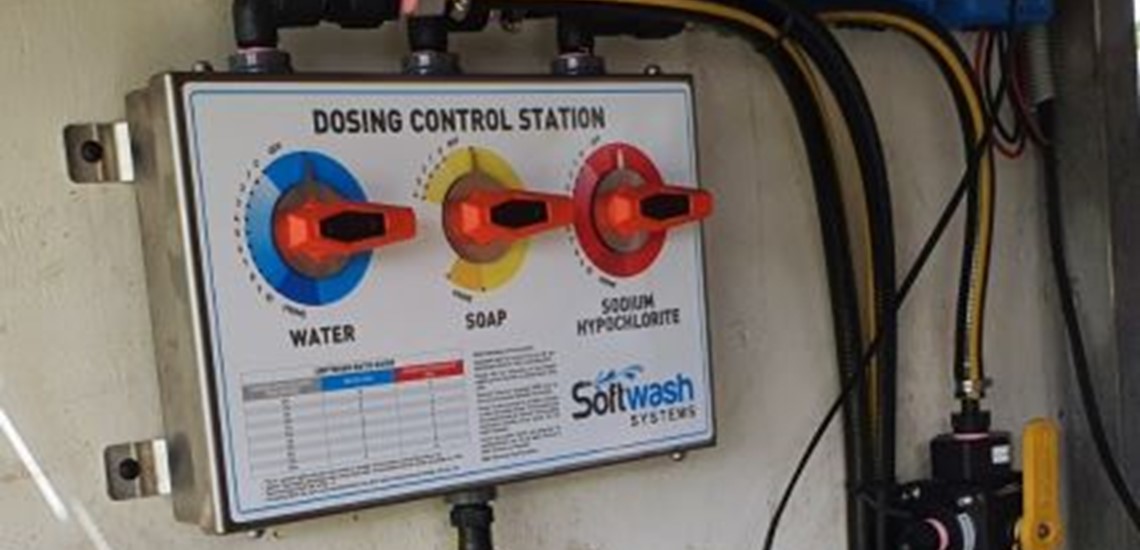Softwashing

What is soft washing
Soft washing has been used overseas for many years although fairly new to Australia. In America it is common as their roofs can be very steep ( to not collect snow) or made of materials that cannot handle pressure washing.
Softwashing is a cleaning method using low pressure and specialized solutions (typically bleach, water, and sometimes a surfactant) to safely remove mildew, bacteria, algae and other organic stains from roofs and other building exteriors.[1] It is so named to differentiate the method from power washing. (1)
Softwashing is the application of the correct products to eliminate mould and loosen dirt so that it can be removed under low pressure. The perfect alternative to pressure cleaning for many more delicate surfaces. The best system sapply at 300 psi, better than a good garden hose and removed under low pressure. See our house washing page to book a free quote.
Cleanupcrew offer this service to make your house or building shine again and also have the best in high pressure equipment for the harder surfaces such as concrete.
We use 12 volt pumps that are powered by solar panels on the roof of our trucks, this is even more eco friendly as softwashing can involve 240 volt pumps and generators or petrol engines. Just a point of difference, looking after the environment.
When should you use softwashing?
On softer surfaces that cannot handle pressure washing and many other areas. You will be delighted in the result as our technicians have vast experience to allow them to use the optimal process to clean your property.
The Softwash process eliminates all plant, fungal, and bacterial life and any dirt and grime from the roof safely, returning it to its original color with no risk of damage to the roofing materials (2)
What chemicals are used to soft wash?
The process involves the integration of sodium hypochlorite, water and a surfactant. All of these are non hazardous.
If you are a professional looking into this form of cleaning, don't be talked into expensive additions to this mix.
Cleanupcrew have worked with industrial chemists to develop to best surfactant available. A surfactant that prolongs the life of you paintwork, leaves windows streak free ( yes we can clean windows and screens without removing them) and adds a hang factor to leave the other chemicals on the surface for longer to work better.
- Sodium hypochlorite - to kill organics such as mould, algae and lichen.
- Water - to dilute the products.
- Surfactant - To loosen any dirt and debris so that it can be washed off at low pressure.
It's like washing dishes, you use a detergent to loosen the food left on the plate to easily remove it.
What is the process of soft washing?
First you prepare your surrounding area and protect any plants or grass you have around the surface area you are cleaning. Then, you prepare the solution (more on that below). Once the solution is prepared, load it into an agricultural sprayer to apply to the surface you are cleaning. Soft washing runs water through a pump and hose with very little pressurization. The pump can also direct the cleaning solution mixture through the hose. Then the hose is directed at the surface being cleaned and the mixture is sprayed out.
The soft wash system normally consists of higher concentration of cleaning solutions and a higher volume of water versus pressure. Application is gentle, with less pressure than what comes out of your garden hose. Once you are done, depending on the surface-like a roof, the solution is left on the surface in order to kill everything down to the roots versus if you have applied it to siding, then it is typically rinsed off. Roof concentrations are typically higher than siding. (3)
Types of softwashing
Another type of softwashing we use involving venturis that deliver the correct products at 300 - 1000 psi. This system has been used to clean large schools and government buildings.
We have found this process to be far more effective when speed and ease of use are required and given the same result. Don't get talked into dedicated pumps unless you are using this for roofs. Connected to a long pressure hose we deliver about 2% sodium hypochlorite and a surfactant quickly at lower pressure. On large commercial jobs we use two operators , one applying and one rinsing, this is our preferred method of softwashing. Using long range nozzles it is far easier to remove wasp nest and debris at 1000 psi than just using traditional softwash techniques. We have searched the world and find Ladder Saver long range nozzles to be the best by far. Google them.
Traditional softwashing only uses about 100 psi so operators have to use long poles to remove nests etc. With our system these can be shot off nests etc up to 3 storeys.
It is so much easier to use this process and you will have pressure if needed on a job.
Do it yourself option
A rectangular bucket and a broom are very useful for the DIY people.
Mix a cup of bleach and a good drop of dishwashing liquid into the bucket. Just mix what is needed as most soaps etc react with SH to render it useless over time. Wet the surfaces to be cleaned and remove any items that won't handle bleach.
Wear the appropriate PPE while doing this as this solution is harmful to eyes and the skin.
Apply the solution to mouldy soffits and give windows and screens a dose.
Then wash off with a garden hose - Simply as that, this will kill the mould and leave the place looking great.
Cleanupcrew is known as the commercial cleaning experts and will always use the best method to clean your building or house.
References:
(1) Wikipedia
(2) https://spaceclean.net/soft-washing-what-is-soft-washing-how-is-soft-washing-done/
(3) https://spaceclean.net/soft-washing-what-is-soft-washing-how-is-soft-washing-done
Specialised services for..